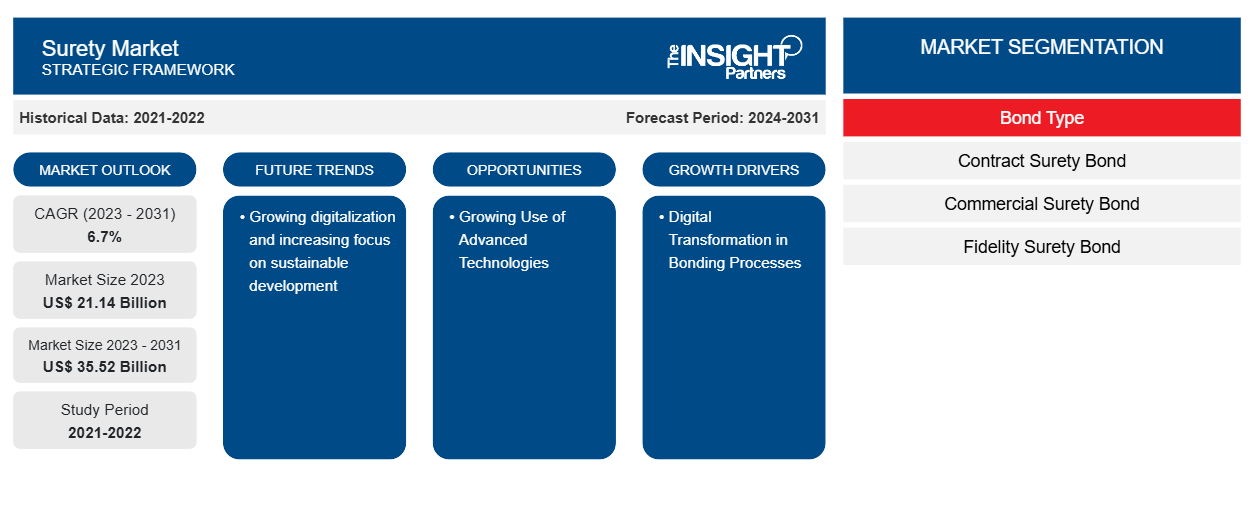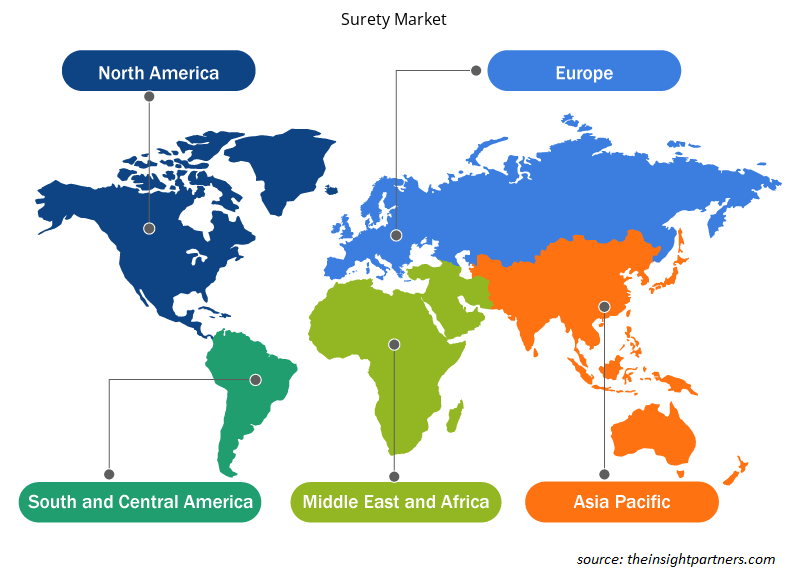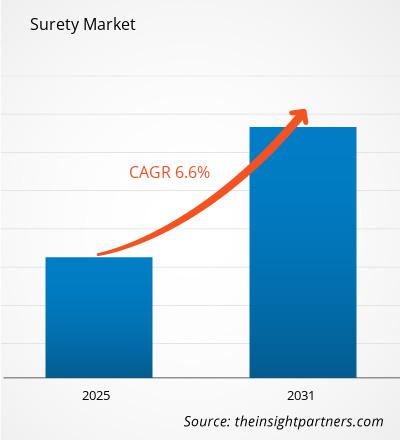Der Bürgschaftsmarkt wurde 2024 auf 20,26 Milliarden US-Dollar geschätzt und soll bis 2031 31,85 Milliarden US-Dollar erreichen. Für den Zeitraum 2025–2031 wird eine durchschnittliche jährliche Wachstumsrate (CAGR) von 6,6 % erwartet. Die zunehmende Digitalisierung und der zunehmende Fokus auf nachhaltige Entwicklung dürften weiterhin ein wichtiger Trend im Bürgschaftsmarkt bleiben.
Bürgschaftsmarktanalyse
Der Bürgschaftsmarkt wächst aufgrund der zunehmenden Anzahl von Bautätigkeiten und der digitalen Transformation von Bürgschaftsprozessen rasant. Der Markt wächst stetig, angetrieben durch die Verfügbarkeit maßgeschneiderter Bürgschaften und die zunehmende Nutzung von Bürgschaften zur Steuerung finanzieller Risiken. Darüber hinaus bieten der zunehmende Einsatz fortschrittlicher Technologien und die verstärkte Fokussierung auf Umwelt-, Sozial- und Governance-Faktoren ( ESG ) lukrative Möglichkeiten für Marktwachstum.
Übersicht über den Bürgschaftsmarkt
Eine Bürgschaft ist eine finanzielle Garantie oder Bürgschaft, ein Versprechen, für die Schulden, Zahlungsausfälle oder das Versagen einer anderen Partei zu haften . Es handelt sich um eine Dreiparteienvereinbarung, bei der eine Partei (der Bürge) die Erfüllung oder Verpflichtungen einer anderen Partei (des Auftraggebers) gegenüber einer dritten Partei (dem Gläubiger ) garantiert. Eine Bürgschaft dient als Zusicherung, dass eine Person oder Organisation die Verantwortung für die Erfüllung finanzieller Verpflichtungen übernimmt, wenn der Schuldner in Verzug gerät und nicht zahlen kann. Die Partei, die für die Schuld garantiert, wird als Bürge oder Garant bezeichnet. Bürgschaften können durch die Ausgabe von Kautionsbürgschaften erlangt werden. Dabei handelt es sich um rechtsgültige Verträge, die eine Partei zur Zahlung verpflichten, wenn die andere die Vereinbarung nicht erfüllt. Diese Bürgschaften werden häufig in der Bau-, Immobilien-, Finanz- und Transportbranche verwendet , um den Schuldner vor Zahlungsverzug des Auftraggebers abzusichern.
Passen Sie diesen Bericht Ihren Anforderungen an
Sie erhalten kostenlos Anpassungen an jedem Bericht, einschließlich Teilen dieses Berichts oder einer Analyse auf Länderebene, eines Excel-Datenpakets sowie tolle Angebote und Rabatte für Start-ups und Universitäten
Bürgschaftsmarkt: Strategische Einblicke

-
Informieren Sie sich über die wichtigsten Markttrends in diesem Bericht.Dieses KOSTENLOSE Beispiel umfasst Datenanalysen, von Markttrends bis hin zu Schätzungen und Prognosen.
Treiber und Chancen auf dem Bürgschaftsmarkt
Die digitale Transformation von Klebeprozessen treibt den Markt an
Die digitale Transformation hat sich in den letzten Jahren zu einem der wichtigsten Treiber entwickelt. Die digitale Revolution im Bürgschaftswesen ersetzt das traditionelle papierbasierte System und unterstützt die Nutzer bei der Reduzierung zusätzlicher Betriebskosten. Traditionelle papierbasierte Systeme werden durch digitale Plattformen ersetzt, die die Beantragung, Genehmigung und Ausgabe von Bürgschaften vereinfachen. Mittelständische Bauunternehmen können den Einsatz dieser digitalen Lösungen in Betracht ziehen, um den Papierkram zu reduzieren, die Effizienz zu steigern und die Bearbeitungszeit von Bürgschaftsanträgen zu verkürzen.issuances. Middle-market construction companies can consider using these digital solutions to decrease paperwork, increase efficiency, and shorten bond application processing times.
Zunehmender Einsatz fortschrittlicher Technologien
Technologie wird in der Kautionsbranche zunehmend an Bedeutung gewinnen. Kautionsorganisationen investieren massiv in fortschrittliche Technologien wie künstliche Intelligenz, Blockchain und Big Data Analytics, um ihre Abläufe zu optimieren und zu verbessern. Blockchain wird beispielsweise eingesetzt, um die Ausstellung von Kautionen und die Bearbeitung von Schadensfällen zu optimieren, während Big Data Analytics dazu beitragen kann, mögliche Gefahren und Betrug aufzudecken. Die erheblichen Vorteile fortschrittlicher Technologien eröffnen im Prognosezeitraum lukrative Marktchancen.
Segmentierungsanalyse des Bürgschaftsmarktberichts
Wichtige Segmente, die zur Ableitung der Bürgschaftsmarktanalyse beigetragen haben, sind die Anleihearten.
- Basierend auf der Art der Bürgschaft ist der Bürgschaftsmarkt in Vertragsbürgschaften, Handelsbürgschaften, Vertrauensbürgschaften und Gerichtsbürgschaften unterteilt. Das Segment der Vertragsbürgschaften hatte im Jahr 2023 einen größeren Marktanteil.
Analyse der Marktanteile von Bürgschaften nach geografischen Gesichtspunkten
Der geografische Umfang des Bürgschaftsmarktberichts ist hauptsächlich in fünf Regionen unterteilt: Nordamerika, Asien-Pazifik, Europa, Naher Osten und Afrika sowie Südamerika/Süd- und Mittelamerika.
Gemessen am Umsatz hatte Nordamerika den größten Marktanteil im Bürgschaftsmarkt, was auf die zunehmende Industrialisierung und die steigende Zahl kleiner Unternehmen in den USA und Kanada zurückzuführen ist. Diese Länder verfügen über eine starke Wirtschaft, und die staatliche Förderung und Gründung von Start-ups beflügelt den Markt. Bürgschaften werden von kleinen Unternehmen häufig genutzt, um Aufträge zu erhalten und ihren Kunden die termingerechte Ausführung und Fertigstellung der jeweiligen Arbeiten zu garantieren. Bürgschaften, die von Bürgschaftsunternehmen ausgestellt werden, werden für eine Vielzahl staatlicher und kommerzieller Transaktionen benötigt. Die wachsende Zahl kleiner Unternehmen in der nordamerikanischen Baubranche sowie die Präsenz einer beträchtlichen Anzahl von Bürgschaftsmarktteilnehmern in den USA und Kanada werden den Bürgschaftsmarkt voraussichtlich ankurbeln.
Regionale Einblicke in den Bürgschaftsmarkt
Die Analysten von Insight Partners haben die regionalen Trends und Faktoren, die den Bürgschaftsmarkt im Prognosezeitraum beeinflussen, ausführlich erläutert. Dieser Abschnitt behandelt außerdem die Marktsegmente und die geografische Lage in Nordamerika, Europa, Asien-Pazifik, dem Nahen Osten und Afrika sowie Süd- und Mittelamerika.

- Erhalten Sie regionale Daten zum Bürgschaftsmarkt
Umfang des Bürgschaftsmarktberichts
| Berichtsattribut | Details |
|---|---|
| Marktgröße im Jahr 2024 | 20,26 Milliarden US-Dollar |
| Marktgröße bis 2031 | 31,85 Milliarden US-Dollar |
| Globale CAGR (2025-2031) | 6,6 % |
| Historische Daten | 2021-2023 |
| Prognosezeitraum | 2025–2031 |
| Abgedeckte Segmente |
Nach Anleihentyp
|
| Abgedeckte Regionen und Länder |
Nordamerika
|
| Marktführer und wichtige Unternehmensprofile |
|
Dichte der Akteure auf dem Bürgschaftsmarkt: Auswirkungen auf die Geschäftsdynamik
Der Markt für Bürgschaften wächst rasant. Die steigende Endverbrauchernachfrage ist auf Faktoren wie veränderte Verbraucherpräferenzen, technologische Fortschritte und ein stärkeres Bewusstsein für die Produktvorteile zurückzuführen. Mit der steigenden Nachfrage erweitern Unternehmen ihr Angebot, entwickeln Innovationen, um den Bedürfnissen der Verbraucher gerecht zu werden, und nutzen neue Trends, was das Marktwachstum weiter ankurbelt.
Die Marktteilnehmerdichte beschreibt die Verteilung der in einem bestimmten Markt oder einer bestimmten Branche tätigen Unternehmen. Sie gibt an, wie viele Wettbewerber (Marktteilnehmer) in einem bestimmten Marktraum im Verhältnis zu dessen Größe oder Gesamtmarktwert präsent sind.
Die wichtigsten auf dem Bürgschaftsmarkt tätigen Unternehmen sind:
- Crum & Forster
- CNA Financial Corp
- Die Travelers Companies Inc.
- Liberty Mutual Holding Co Inc
- Die Hartford Insurance Group, Inc.
- Chubb Ltd
Haftungsausschluss : Die oben aufgeführten Unternehmen sind nicht in einer bestimmten Reihenfolge aufgeführt.

- Überblick über die wichtigsten Akteure auf dem Bürgschaftsmarkt
Neuigkeiten und aktuelle Entwicklungen auf dem Bürgschaftsmarkt
Der Bürgschaftsmarkt wird durch die Erhebung qualitativer und quantitativer Daten aus Primär- und Sekundärforschung bewertet. Dazu zählen wichtige Unternehmenspublikationen, Verbandsdaten und Datenbanken. Nachfolgend finden Sie eine Liste der Entwicklungen im Markt für Telekommunikationsabrechnung, Umsatzmanagement und Strategien:
- Core Specialty Insurance Holdings, Inc., ein Sach- und Unfallversicherer, übernimmt American Surety im Rahmen einer Aktien- und Bartransaktion. Damit entsteht neben den Bereichen Specialty Casualty, Property & Short-Tail und Fronted Programs ein neues Untersegment für Anleihen, Kredite und Garantien. Der Abschluss der Übernahme wird für das erste Quartal 2024 erwartet. (Quelle: Core Specialty Insurance Holdings, Inc., Pressemitteilung 2023)
Bürgschaftsmarktbericht – Umfang und Ergebnisse
Der Bericht „Surety Market Size and Forecast (2023–2031)“ bietet eine detaillierte Analyse des Marktes, die die folgenden Bereiche abdeckt:
- Marktgröße und Prognose auf globaler, regionaler und Länderebene für alle wichtigen Marktsegmente, die im Rahmen des Berichts abgedeckt sind
- Marktdynamik wie Treiber, Hemmnisse und wichtige Chancen
- Wichtige Zukunftstrends
- Detaillierte PEST/Porters Five Forces- und SWOT-Analyse
- Globale und regionale Marktanalyse mit wichtigen Markttrends, wichtigen Akteuren, Vorschriften und aktuellen Marktentwicklungen
- Branchenlandschaft und Wettbewerbsanalyse, einschließlich Marktkonzentration, Heatmap-Analyse, prominenten Akteuren und aktuellen Entwicklungen
- Detaillierte Firmenprofile
- Historische Analyse (2 Jahre), Basisjahr, Prognose (7 Jahre) mit CAGR
- PEST- und SWOT-Analyse
- Marktgröße Wert/Volumen – Global, Regional, Land
- Branchen- und Wettbewerbslandschaft
- Excel-Datensatz
Aktuelle Berichte
Erfahrungsberichte
Grund zum Kauf
- Fundierte Entscheidungsfindung
- Marktdynamik verstehen
- Wettbewerbsanalyse
- Kundeneinblicke
- Marktprognosen
- Risikominimierung
- Strategische Planung
- Investitionsbegründung
- Identifizierung neuer Märkte
- Verbesserung von Marketingstrategien
- Steigerung der Betriebseffizienz
- Anpassung an regulatorische Trends






















 Kostenlose Probe anfordern für - Bürgschaftsmarkt
Kostenlose Probe anfordern für - Bürgschaftsmarkt